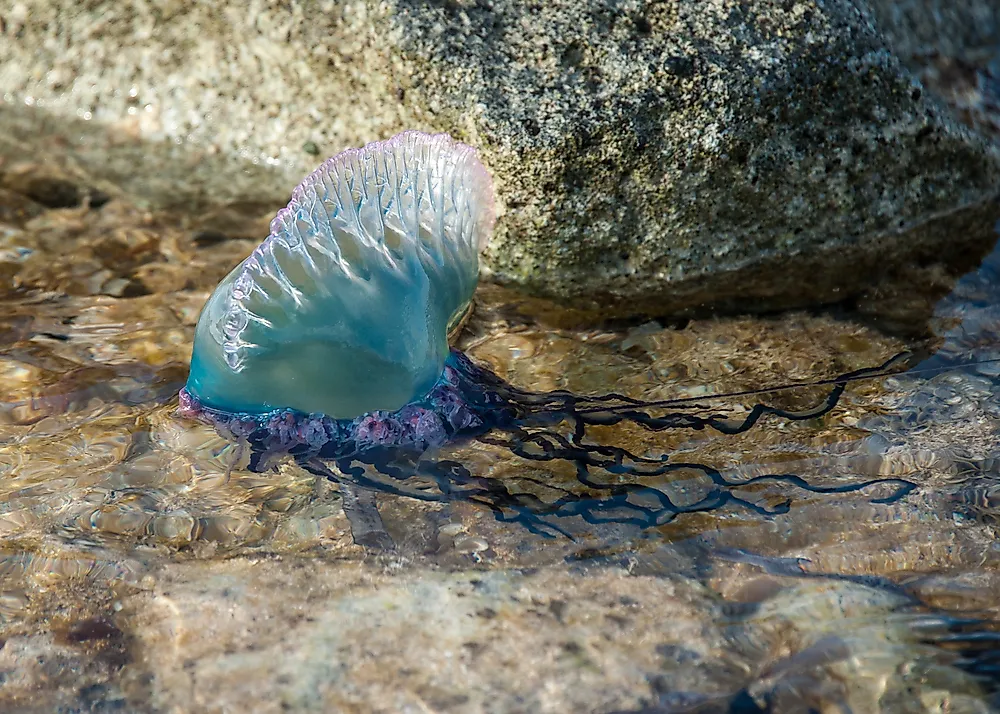10 Interesting Facts About The Portuguese Man-of-War

The Portuguese Man-of-war, a marine hydrozoan found in the Atlantic, Pacific, and Indian Oceans, is like no other creature on Earth. Infamous for its highly potent toxin that can kill even a human, the man-of-war is a creature that is best avoided. However, there are many interesting facts associated with this unique creation of nature that has been mentioned below.
A Portuguese Man-of-war Is Four Organisms Appearing As One
The Physalia physalis is a miracle of nature, a creature that is actually made of four organisms functioning and appearing as one. These organisms are called zooids. They cannot live independently but exist as part of a colonial animal. The Portuguese Man-of-war’s four zooids have specialized functions. The top zooid that resembles a jelly-like blob (pneumatophore) with a mohawk-like feature running along its length functions to keep the creature afloat in the sea. The tentacles of the creature are made of gastrozooids (for feeding) and dactylozooids (for capturing prey and defense). The fourth zooid functions to aid reproduction and is called gonozooid.
Not A Jellyfish Although It Appears Like One
With its inflated pneumatophore and tentacles, the Portuguese Man-of-war is said to resemble a jellyfish. However, although both are members of the phylum Cnidaria with thousands of other animals, the Portuguese Man-of-war is not a jellyfish at all but a completely different species. Although a jellyfish is a single organism, the Physalia physalis is a complex of four zooids.
The Name Of The Creature Has A Naval Connection
The mohawk of the Portuguese Man-of-war is said to appear like sailing ships used by the Portuguese navy in the 15th and 16th centuries. It may also refer to the helmets worn by Portuguese soldiers during the same period.
It Delivers A Fatal Venom
Those who know the sea well would always try to keep a safe distance from this deadly creature. The Portuguese Man-of-war delivers a venomous sting that can kill its prey instantaneously. Human victims of such stings also suffer greatly and fatality cannot be ruled out if the wounds are left untreated for long. The dactylozooids of the creature are covered in nematocysts that are filled with lethal venom. The tentacles can grip the prey and inject the venom into it. In humans, stings by the Portuguese Man-of-war leaves whip-like lacerations on the skin that are accompanied by intense pain. More serious conditions result when venom travels to lymph nodes to cause a moderate to a severe allergic reaction that can cause fever and shock, and in extreme cases, even death.
Man-of-War Tentacles Can Be Up To 165 ft Long
Although the dactylozooids are generally 30 feet long, specimens have been found where the dactylozooids grow even longer. The longest Man-of-War tentacles ever recorded was 165 feet long.
It Can Fall Apart But Still Kill
Interestingly, the entire Portuguese Man-of-war is not needed to deliver its venom, only its tentacles will do. As mentioned previously, this creature is composed of four zooids. If the dactylozooids detach from the creature, it can survive for some days in isolation. During this time, the detached tentacles can sting anyone approaching them and deliver the venom. Even the dead Portuguese Man-of-war that washes up on shore can sting as its tentacles might remain in action to strike anyone approaching the dead creature.
The Sea Takes The Portuguese Man-of-War With It
The Portuguese Man-of-war lacks any locomotory organs. It simply drifts with the sea currents or sails with the sea breeze. The pneumatophore can also be temporarily deflated if the creature is threatened. It causes the creature to sink below the water. If winds or ocean currents are too strong, the Portuguese Man-of-war might accidentally land onto beaches. Even in this condition, the creature can sting.
The Man O’ War Is Not Always Alone
It is not unusual to see hundreds to thousands of these creatures floating on the sea. Hence, entire beaches are often shut down when one such creature lands on the beach as the possibility of more of them drifting nearby is quite high.
Other Creatures Live In Its Deadly Tentacles
Although most creatures of the ocean and all humans who know about it will stay away from the Man-of-war, some marine creatures prefer to live with it. For such creatures like the small Nomeus gronovii or man-of-war fish, the venom-bearing tentacles of the Portuguese Man-of-war are a haven where they remain protected from external threats. Such fish have immunity to the venom of the creature. The fish, in turn, help the Man-of-war in attracting other fish that serve as its prey.
Lethal Sting Does Not Deter Its Predators
Despite its deadly sting, the Portuguese Man-of-war often turns out to be the food of other sea creatures. The predators of this creature are all well-adapted to hunt the Portuguese Man-of-war without themselves getting envenomated in the process. The Physalia physalis is gobbled up by the loggerhead turtle and the ocean sunfish. The blanket octopus also relishes on consuming the Man-of-war.











